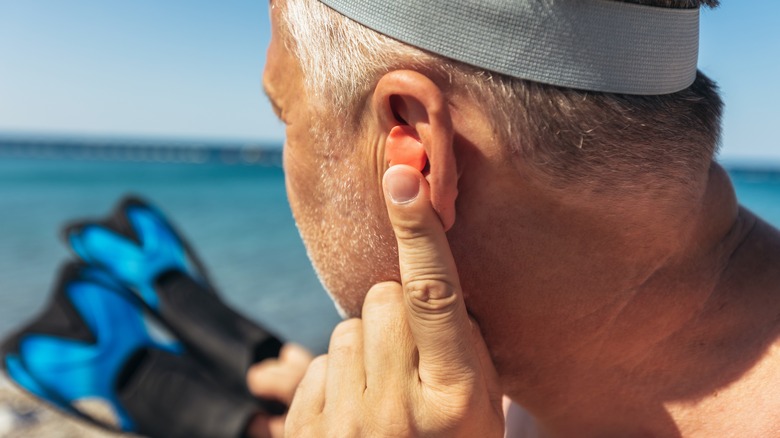What Happens If You Don't Treat Swimmer's Ear?
Despite its name, swimmer's ear can affect more than just those who swim, according to UNC Health Talk. In fact, 10% of people experience swimmer's ear at one time or another during their lives. Characterized by inflammation of the outer ear canal, common symptoms associated with swimmer's ear include redness, itching, pain, pus drainage from the ear, swelling of the neck glands or ear canal, muffled hearing, and more (per Johns Hopkins Medicine).
Otherwise referred to as otitis externa, swimmer's ear is a painful ear infection that is often the result of bacterial growth, particularly that of Pseudomonas aeruginosa or Staphylococcus aureus (via UNC Health Talk). Frequently caused by swimming in unsanitary water, moisture can become trapped in the ear canal, providing a cozy home for bacteria to thrive, explain experts from Johns Hopkins Medicine.
Yet water is not the only thing that can prompt a case of swimmer's ear. Dr. Christine DeMason, an ear, nose, and throat physician at UNC Medical Center in Chapel Hill tells UNC Health Talk, "Lots of people who get swimmer's ear don't go near the water. Sometimes people try to clean their ears with cotton swabs. This can cause damage or irritation to the lining of the ear canal, and that gives bacteria a way to get in and cause an infection." In addition to cotton swabs, experts advise keeping fingers, sand, and other loose debris out of one's ears to help reduce the risk of swimmer's ear.
Protect yourself against swimmer's ear
Without proper treatment, a case of swimmer's ear can lead to repeated ear infections or hearing loss (via Johns Hopkins Medicine). The spread of infection may also impact neighboring tissue, nerves, or the brain. In severe cases, bone or cartilage damage may occur. Additionally, the condition could progress into a deep tissue infection known as cellulitis (per UNC Health Talk).
Treatment for otitis externa often entails the use of pain medication as well as antibiotic or corticosteroid ear drops, according to Johns Hopkins Medicine. With proper physician treatment, swimmer's ear usually heals within a week to 10 days. To help protect against swimmer's ear, experts suggest utilizing ear plugs while in the water. Afterward, tilt your head from one side to the next and lightly tug on your earlobe to help drain the ear of any remaining moisture. Use the outer edges of a soft towel to gently dry the ear. You can also try blow drying your ears. Be sure to use the lowest speed and coolest temperature setting. When doing so, keep the blow dryer moving rather than stationary, and maintain a distance of 1 foot or more from the ear.
The U.S. Centers for Disease Control and Prevention (CDC) suggests keeping track of disinfectant levels and pH levels in pools and hot tubs to make sure they're safe to swim in. You can do so yourself by using test strips or by consulting with the facility's pool or hot tub operator.


